|
|
| 『長谷川時夫氏にインドパドマブーシャン賞を』日本側後押し応援団のメンバーになった在日インド人のカプール氏がインド人目線でミティラー美術館を評価してくださいました。 |
| ■(株)レオナールドインターコミュニケイションズ 代表 C.M. カプール 氏 |
長谷川さんの偉大な業績に対してデリー大学の学者たちがインド政府の最高賞でもあるパドマ・ブーシャン賞に昨年に続いて今年も推薦しノミネートされました。日本人は6人ほど受賞、今も活躍しておられる方はスズキ自動車会長鈴木修氏、オリンピック委員会会長元首相の森喜朗閣下です。この栄誉ある賞に長谷川氏が並ぶことに違和感を感じられるのではないかと想像しますので、インドから見てどのような業績を残されているかについて書いてみたいと思います。 まず多くの日本人がご存知のように、インドがIT分野で活躍する国であり、2027年には人口が世界一となります。また数年以内には日本のGDPを上回り、世界第三位の経済大国になると予想され、インドは少しずつ日本の方に関心を持たれ始めています。 新潟県十日町の雪深い森にあるミティラー美術館は廃校の小学校を使い40年近く、インドにとって重要なミティラー画のために活動がされています。それにもかかわらず、未だに美術館の雨漏りや下水道がない山の中での旧式のトイレの問題で困っているところを見ますと、インドに対して、日本の国民がカレー、象、ターバンを巻いた人々が暮らしている国という、インドの一面だけを見ている方が未だに多いのではないかと思いました。 インドは広く多民族国家、一言で表現できる国ではないということが昔から言われてきました。インドの国土は日本の9倍、人口は11倍近くあります。面積的にヨーロッパ、今のEUと比較して説明する試みがあります。ヨーロッパの代表的な言語は24ですが、インドは英語も入れて24言語が代表的です。イギリスがEUから離れたのでEUの加盟国は27カ国、インドは28州、連邦直轄領は9となっています。人口ではEU全体4億7000万人の3倍近くもあります。しかしEUでは類似の言語を話されていますが、インド国内の言葉は日本、韓国、中国、ベトナムと同程度の、大きな差異があります。 経済大国になろうとしているインドが、世界の中で尊敬される国になるためには、自国の文化について国際的に発信していかなくてはなりませんが、このように多様性が高い国なので、優れた地方文化があっても、自国の中でも、なかなか全国的に評価してもらうことができません。そんな中で、長谷川氏は、ビハール州のミティラー画の美術館を日本につくって、この美術の重要性を世界に向けて発信してくれました。その結果、ミティラー画がインド全体にとって、また世界にとって重要な富であるという認識を広めてくれたのです。 長谷川氏のコレクションしているミティラー画は仏陀が活躍した地域でもありビハール州を代表する絵画です。ビハール州の人口は1億2000万人。今インドではメイクドインディアという国策に基づき手作りに力を入れています。ミティラー画の描き手が増え本拠地のマドゥバニの駅をミティラー画で埋め尽くしたり、州都パトナにある塀のあちこちに壁画を描いたり、ビハールを通る汽車にミティラー画を描くなど、インド国内でも大変話題となっています。 しかしながら、次の時代を背負うミティラー画の大勢のアーティスト、手工芸者にとって、有名なミティラー画の著名な方々の絵をSNSや稀に手に入る本を通してしか見ることができないのです 2年前にビハール州の州首相ニテッィシュ・クマール氏が東京と大阪で経済セミナー会場で長谷川さんのことをお話しになりました。はじめに「日本とインドの友好関係は精神的相似と文化と文明の繋がりに根ざしている」、続けて日印の交流の始まりと言われる日本に最初に来たインド人であり、僧侶の菩提僊那が752年に東大寺の大仏開眼式において聖武上皇に代わり開眼導師を務めたことを語りました。続けて、次の言葉を述べられています。「非公式な文化交流は日印間では長期間行われていた。この素晴らしい例としては日本の中のミティーラ美術館である。インドから何千マイルも離れた場所に、ビハールの伝統的ビハール絵画が日本にオアシスを見つけた。ミティーラ美術館は日本の新潟県の十日町にあり、長谷川時夫氏の頭脳の産物であり、ここは15,000枚の絶妙なミティーラ絵画が収納されている宝の家である。」 州首相がこのとき、ミティラー美術館を訪問することを希望されていましたが、2月という雪の多い季節のため断念しました。東京での会場となったインド大使館にあるエントランスで長谷川氏はミティラー画の宝物を並べた展示会をしてくれました。その模様がビハール州のメディアに取り上げられ多くの手工芸者の知ることとなりました。昨年日本の有名な建築家槇文彦氏の設計のビハール博物館での1月の国際セミナーでは長谷川氏はメインゲストとして招待されミティラー画の守護者として有名な映画俳優のように評判だったと聞いています。 その後縁あってミティラー画の現地を訪れ、ミティラー画の現状を見て、近代化とともに散逸した浮世絵を思い、この絵画を集め、守っていけばいつか世界にとって役立つだろうと思いました。また江戸っ子の私にとって明治開国は他のアジア諸国のように列強の植民地にならなかったのは、幸運であったと思うが、西欧の文化を急速に取り入れ、近代化を達成する中で文化的には植民地になったように思える」その想いと心の痛みが、日本の有名な浮世絵のような運命にミティラー画がなるのではないかと思いをはせたことが、彼が40年にわたってミティラー美術館を継続してきた動機であることを知り、イギリスの200年近くにわたる植民地支配を経験してきたインド人の私にとって共感し頭が下がる思いがしました。なぜなら今やミティラー画の著名な描き手が何人も亡くなり、それらの絵画を後継者がなかなか見ることができないからです。 さらに、驚くべきことは1988年に日本で開催されたインド祭に日本委員会事務局長補佐で活躍した88'インド祭から長谷川氏はミティラー画のアーティストを日本全国に展開する展覧会場に長期のアーティスト・イン・レジデンスとして20年近くにわたって精力的に展開してきたことです。呼ばれたアーティストはミティラー画にとどまらず、ワルリー画、ゴンド画、インパールの著名な陶工、つまり当時のインドを代表するフォークアーティストたちが、集結したのです。しかも売るための作品作りではなく、美術館で展示できるような時間をかけた、大型作品がインドの主力アーティストたちによってたくさん生まれたのです。 今私たちはミティラー美術館の主要コレクションを見ると眩いばかりの作品に出会います。このような作品を村落のアーティストが日本での生活体験を通しただけで生まれたのでしょうか、それは否です。インドのフォークアートを代表するガンガー・デーヴィーさんは3回ほど日本に来日し長谷川氏を公に自分の息子と呼んだことがあるほど、長谷川氏の家族、スタッフを含み生活をともにする中で親交を深めました。彼女の代表作『人の一生』はインディラ・ガンジー首相がインド文化を世界に伝えるためにサッチャー首相と話し1982年に始めたインド祭の為に描き始めた絵画です。ガンガー・デーヴィーさんの絵画はその時にアディティーという展覧会の目玉として描かれたもの。病弱な彼女は完成まで2年近くかかりました。本人の希望で世界で唯一のミティラー画の美術館に収蔵して欲しいと言う願いで長谷川氏のミティラー美術館収蔵品となったものです。全く同様の『人の一生』は、米国でのインド祭での同展で彼女はもう一枚インド側インド祭委員長のププル・ジャヤカル女史より頼まれ描きました。その作品はデリーの国立手工芸博物館に収蔵されています。この博物館はガンガー・デーヴィーさんの作品を30点ほど収蔵、ミティラー美術館は36点を収蔵しています。他に、公的機関が収蔵している話は聞いた事がありません。不幸にも癌が完治した後に白血病によって1991年に亡くなったガンガー・デーヴィーさんの最後の大作『スーリヤムッキーの木』の絵は日本のミティラー美術館で描かれました。昨年パドマ・シュリー賞を受賞したミティラー画のゴーダーワリー・ダッタさんの作品や他のアーティストのほとんどの主要作品が日本滞在中に描かれたものです。ゴーダーワリー・ダッタさんの要望に応えて長谷川氏は大きなキャンパス、アイディアを提供し、彼女の代表作シヴァ神のもつ三つ叉の槍『トリシューラ』も日本で生まれました。ワルリー画の創設者として知られる故ジヴヤ・ソーマ・マーシェさんは3度ほど日本に長期滞在。毎回6ヶ月におよぶ滞在の間、横3mを超える大作を何枚も残しました。インドの5大フォークアーティストの一人と評価されるマニプール州インパールの女性陶工ニラマニ・デーヴィさんは日本に3ヶ月ほどの滞在でしたが、日本の土を使って娘と200点におよぶ新しい作品を残しました。インパールの黒っぽい土で作られた大きな作品は、日本で制作した作品と比べ少し地味ですが30点程度、国立手工芸博物館に今も収蔵されているそうです。長谷川氏はインパールではほとんど顧みられることの少なかったニラマニ・デーヴィの展覧会を将来、国立手工芸博物館と合同でインパールで開催したいそうです。日本に2度来日したゴンド画の創設者として知られるジャンガル・シンさんは若くして亡くなりましたが、日本滞在中に長谷川氏とのコラボレーションにより巨大な飛行機を中心に7つの飛行機を描いた作品や他にも新しい作品が日本で生まれました。最初にミティラー美術館に来た時、沢山の彼の作品を持って来たそうで、その作品を長谷川氏は全て購入して彼を経済的に支援しました。日本で描いた大作作品群と共に重要なコレクションとなっています。現在、インド政府が日本企業と進めようとしている、日本の得意なハードや繊細な技術、インドの得意なソフトの共同によるイノベーションをアートの世界で日印の協力によって30年以上も前からコラボしてたくさんの素晴らしい作品が生れたのは奇跡的な事だと思います。特に今現在もミティラー美術館に文化遺産として守られているのは称賛に値します。 |
| 【▲ページトップへ】 |
| An Indian in Japan, Mr. Kapoor, Member of the team supporting the nomination of Mr. Hasegawa Tokio for the Padma Bhushan Award from India evaluated the Mithila Museum from an Indian perspective. |
| ■C.M. Kapoor, Managing Director, Reonald InterCommunication Inc. |
Mr. Hasegawa Tokio was nominated again for Padma Bhushan, the highest award of Govt. of India this year by Society of professors and scholars of Delhi for his great contribution. The receivers of the said award of Japan are around six only. India is a country which is successful in IT field of the world. The population of India is anticipated to be the biggest in the world in 2027. Within a few years, GDP of India is estimated to be more than Japan, and is expected to be the world’s third economic power and Japanese are gradually more interested to know about India. He founded Mithila Museum in the middle of forest of Tokamachi-shi, Niigata which has heavy snowfall and continued to have the cultural activities for last forty years for Mithila painting which is important cultural produce of India. When I come to know he is facing multiple problems such as rain water leaking, no water passage which makes the setup of modern toilet facility, I have to make a conclusion that major part of Japanese do not much understand India deeply and curry, turban, and elephant are common nouns for them about India. India has multiple kind of humans and is known as the country which is not comprehensive easily. The area is 9times bigger than Japan and the population is 10 times more than Japan. The areawise it can be understood as whole of Europe. There is a way to compare with present EU. Europe has 24 languages totally, and India has 24 languages including English. Considering England leaving EU, now 27 countries are in EU. India has 27 states (Nine states are directly connected from the center) The population of total EU is 470 million but India has three times of EU. Similar language is spoken in EU but the one spoken within India has a major difference like Japan can be compared countries’ language of China, Korea, Vietnam India, to be economically and culturally to be highly praised needs to show its cultural part globally. But due to its multiple and complexed nature, the locally excellent culture is hard to reach to whole India. But Mr. Hasegawa founded a Mithila Museum to help informing the world the importance of the amazing culture. Consequently the understanding the cultural heritage of India and the world becomes the point of importance. The Mithila painting collected by Hasegawa is a representative art item of Bihar state which has a deep root in Buddha and Buddhism. Bihar state has a population of 120millions National slogan of India is “Make in India “and is promoting handmade items. In Madhubani, main city of Bihar has increased numbers of Mithila painting artists and the station is filled with the Mithila painting. In Patna, capital of Bihar, you will find the paintings are on the walls, and on the train which are passing Bihar. Such attempt is increasing the popularity for Mithila paintings in all over India. However, for upcoming artists of Mithila painting it is quite impossible to see the ones created by renowned great artists except by SNS or through rare books. Mr. Nitish Kumar, state prime minister of Bihar visited Tokyo and Osaka two year ago spoke about Hasegawa in the economic seminar. He started the speech with the root of friendship between Japan and India is in the spiritual background and the connection of civilization and culture. The relation between two countries started with Indian who came to Japan. He was a Buddhist monk Bodhisena who was a spiritual guru and took the role of Ex emperor Shoumu for the ceremony of opening eyes of Big Buddha Statue of Todaiji Temple. Further, he spoke, “Many informal cultural relation continued between Japan and India afterwards. But the most marvelous example is Mithila Museum. The traditional painting of Bihar found an oasis in Japan many thousand miles away from Bihar. Mithila Museum is located in Tokamachi, Niigata and it is a brain child of Mr. Hasegawa Tokio. Here 15000 pcs. of Mithila painting is kept and exhibited. Chief minister, wished to visit Mithila museum, however had to leave the idea as it was February having a heavy snow fall. Mr. Hasegawa gave an exhibition in the Embassy of India, Tokyo. showing those treasure. The media of Bihar informed the incident in many papers and Handicraft artists of Bihar came to know. Mr. Hasegawa was invited as a chief guest in January to the Museum of Bihar, designed by famous Japanese architect, Mr. Maki Fumihiko. He, being regarded as a Protector of Mithila arts and painting was welcomed with a fondness like a film star. How he could continue his activity by digging the piled snow from the roof and around the museum by himself and protected the village folk art of other country is amazing. “ I am a 14th generation of Edo period resident called Edokko. In the beginning of 1970, Tokyo was covered with a chemical smog and could not view moon. I decided to move away from Tokyo and shifted to deep inside the forest of Tokamachi, Niigata which has the heaviest snow fall and snow pile up to the height of 4m. A few years later after his shifting, the project started to develop the area, and he offered an alternative idea to save the abandoned primary school and make it the base for social education based of idea of cosmology and the agreement was made with the Municipality. Through a karmic incident he visited the place of Mithila painting. When he saw the situation of Mithila painting, he recalled the tragic history of Japan that Ukiyoe, famous painting of Japan was almost lost from Japan with modernization and he did not want the Mithila painting will follow the same destiny and he decided to start the collection and protection of the painting which will one day be a help for the world. He said though Japan was not colonized after Meiji era, with the rapid adaptation of continental culture in the modernization process Japan was colonized culturally in a way. When I understood his motive, I being an Indian had an empathy for his thought for independent India and admired him as now it is not possible to meet the successors of the art as main great artists of Mithila painting went away to heaven. Another amazing contribution of Hasegawa Tokio was he cooperated fully for Festival of India 1988 as a deputy secretary general of the Japanese committee for the festival. Since then he continued to hold the exhibition in all over Japan taking the artists of Mithila painting who were the artists in residence invited for a long term. The invited artists include Warli painting, Gond painting, and renowned potter of Imphal. He invited those great artists and many large sized paintings were created by main famous artists in the Mithila museum so that regular exhibition could be possible to be held. The Warli painting is other main collection of Mithila Museum. It is the folk art of Maharashtra state of which Mumbai is the capital. The population of the state is 130millions. Many artists Hasegawa invited are Padmashree awardee. It is most unfortunate now in India it is impossible to view those paintings done by great artists. When we visit Mithila Museum, we get to see marvelous paintings. We wonder how the village artists of India could create such amazing paintings. Is it just by experiencing the living of Japan.? Now Govt of India plans to develop a innovative project with Japanese firms. It is a technology of fine Hardware of Japan and Software developed by experts of india. The collaboration of Japan and India was already created thirty years ago miraculously in the field of art. The fact the cultural heritage of India is well preserved in Mithila Museum is praise worthy. |
| 【▲ページトップへ】 |
| 長谷川時夫に関係する推薦文 |
| ■2020年 国際交流基金賞への推薦文 (公財)日本博物館協会 専務理事 半田昌之 氏 |
世界はいよいよ危機的な局面に入っている。2011 年 3 月 11 日の東日本大震災による福 島原子力発電所事故による災害、世界的な気象異変になる大規模災害の多発、さら に、新型コロナ・ウィルスの世界的大流行。こうした問題はいずれも、人間と自然の 関係、大都市圏に人口が集中する暮らし方について、根本的に再考することが不可欠 になっていることを意味している。 国際交流基金賞の趣旨は、国際交流に貢献した人物や団体を表彰することだという が、こうした危機的な局面において、国際交流のあり方について根本的なところから 考え直し、これからの時代の国際交流の指針となるような人物や団体に光を当てる必 要があるのではないだろうか。私が、長谷川時夫を推薦するのは、そうした視点から 注目すべき人物だからだ。 長谷川の日印文化交流をめ ぐる実績はきわめて大きく、日本では限られた範囲でし か知られていないが、インド、特にビハール州では、地域の重要なフォークアートを 守ってくれている恩人として、広く知られ、尊敬を集めている。日印文化交流におけ る彼の多面的な貢献を可能にしたのは、「エコロジカルな暮らしを通じて培われた思想 をベースにした国際交流」という特質があったからだと考えることができる。この特 質は、これからの時代の国際交流のあり方を探る上で、ひとつの重要な指針になると 思われる。 エコロジカルな暮らしと思想をベースにした国際交流長谷川は、若くしてタージ・マハル旅行団の中心メンバーとして、世界で公演活動を行なったが、70年代はじめに、日本に戻ってから、新潟県十日町の豪雪地帯でひどく過疎化が進んだ大池集落に定住した。「売れる音楽家」になるべく時代に媚びることを嫌い、自然の豊かな環境の中で暮らしながら、感覚を研ぎ澄まし、生き物たちや月や太陽、宇宙と共感する思想をつくっていくことをめざした。 
長谷川が十日町・大池の自然の中でのエコロジカルな暮らしを重ね、生き物たち、月や太陽、宇宙と対話しながら、つくりあげてきた思想と、ミティラー地方の女性たちの暮らし方と自然や宇宙への向き合い方の間には、文化や風土は異なるものの、照応(correspond)する関係があった。長谷川にとっても、ミティラー地方の女性たちにとっても、深い照応関係にある他者を発見することを通じて、自分たちの仕事について考える多元的な視野を得ることができるようになる。国際交流、異文化コミュニケーションの本来の意義は、こうした点にあるといっていいのではないか。
長谷川は、長年、完全な菜食主義の暮らしをしている。肉、魚、乳製品を食べない。蕎麦屋に入っても、かつお出汁のつゆは摂らない。 菜食になったきっかけは、冬場の大池での暮らしの中での出来事だった。家の戸を開 て、吹雪の音に聞き入っていた。そんなとき、小さな兎がすぐ目の前を横切ろうとした。その時、兎が彼を少し見た。野生の美しい小さな兎の姿に、心から嬉しくなった。兎の目には、孤独とか生きるのが辛いとかはなく、素朴で美しい目だった。小さな兎が武器も持たず雪の中に消えていくのを見て、冬の孤独な生活に苦しんでいた長谷川は、仔兎の方が自分より上だと感じた。それから、兎が彼のグル(師匠)になった。師匠を食べるわけにはいかないので、菜食になったのだ。森での生き物たちとの出会いは、人間に従属する生き物という西洋思想が根底にある現代社会から自然との共生に向けた思想へと彼を導いた。そして、後に、インドの菜食主義もガンジーの非暴力の思想も、他の生命を害してはならないという「アヒンサー」の原理に由来することを知った。これも、大池での体験から生まれた長谷川の思想とインドの伝統的思考との照応関係といえる。
彼が始めたのは、ニュージャズだった。ベトナム戦争にかり出された黒人たちの怒りと悲しみは、モダンジャズでは表現しきれなくなり、破壊的で自由の極限ともいうべき、パワフルなニュージャズが生まれた。ところが、ジョン・コルトレーンなど先鋭な表現は、日本の大人のジャズ・ミュージシアンにとってもなかなか理解しにくいものだった。しかし、高校生の長谷川には、彼らの奏でる音に込められた怒りや悲しみを感じとることができた。14代目の江戸っ子で下町育ちの長谷川の幼い頃から周りから聞こえていた浄瑠璃などの音と感情表現が、コルトレーンなどの音楽と照応することに、彼は気づいたのだ。こうして、長谷川は、ニュージャズを経由して、仏教思想につながる諦観、無常、空なるものなど、アジア文化へと導かれた。テナーサキソフォンを捨てて、お経をニュージャズのように歌うようになり、仲間たちとタージ・マハル旅行団という東洋的志向をもつ前衛音楽グループのヴォーカルとして活躍することになった。
以下、長谷川の活動実績を、3つのテーマに分けて整理する。 ミティラー美術館におけるインド民俗画の制作とコレクションミティラー画の世界一のコレクションを持つようになったミティラー美術館が開設されたのは、1982年のことだ。
ナマステ・インディアの継続と発展
日本の僻地にあるミティラー美術館でインドの民俗(族)アーティストが制作した絵画や等身大の張りぼてや2mもある巨大な素焼きの馬など、魅力ある規模の大きな民俗(族)アートが会場に毎年公開される。私が「たばこと塩の博物館」の学芸部長の時代、博物館視聴覚ホールをイベントの第二会場として(公財)日印協会主催の講演会に協力した。 この催事は日本商工会議所、日印経済委員会が中心となり1993年に始まった。1991年にインド政府が独立後、初めて経済を開放政策に舵を切った。しかし他国に比べ日本の進出は遅く、その原因の一つであるインド文化に対する関心、理解のなさを解消しようとナマステ・インディアが始まった。長谷川は協力を要請され、毎年インドから舞踊、音楽グループを招聘し魅力あるイベントにする一翼を担った。初期の開催地墨田区役所スペースから無償で提供された築地本願寺での催事には7000人近い人が集まるイベントに成長した。しかし2004年に日本経済の停滞を受け、日本側が手を引くことになった。長谷川は「清水寺から飛び降りる」つもりで引き継ぎ、2004年は事務局として、2005年以降は主幹となって、それまでの築地本願寺から代々木公園に会場を移し、運営体制をつくりなおし、今日に至っている。 東京で評判のこのイベントは長谷川の「エコロジカルな暮らしと思想をベースにした国際交流」の精神が滲んだものとなっている。 「たばこと塩の博物館」では来年「ミティラー美術館コレクション展」を16年ぶりに開催するそうだが、私が在職中に、このコレクションを5回開催した。92年「インド先住民族アート展」ではアイヌ民族の地位向上に国会を通して多大な貢献した参議院議員の萱野茂氏が講演をされた。萱野氏は会場でワルリー画のジヴヤさんの公開制作を見て感動された。特に今でも*ワルリー語を話しワルリーの文化が継続している事*に強い関心を持たれた。会場で公開制作された絵を北海道二風谷にある萱野茂アイヌ資料館へ寄贈するために、長谷川と私は、車で運んだ。 *__* 明治政府の同和政策によりアイヌ語を話せる人は少なくなっている。 この展覧会が契機となり、翌年トヨタ財団の助成で、現地での日中共同研究が長谷川代表の下、実現した。 その後、長谷川は南太平洋諸国文化も日本に紹介している。パプアニューギニア、アボリジニー、マオリ族など、西洋文化に影響されてない独自な民族文化を保持するグループを大都市から遠く離れた地域に住む人々を選び、招聘し全国展開している。 2000年にパプアニューギニアの民族のかたち「くらしの中の神々」をたばこと塩の博物館で開催した。十日町市の隣の旧塩沢町にある旧今泉博物館(現今泉資料館)収蔵の世界一のセピック川を中心とする5000点近いコレクションと故今泉氏が鶴ヶ島市に寄贈した1500点(現在は国立民族学博物館他2施設に分散寄贈している)から展示物を選ぶというものだった。この類稀なコレクションを集めた方の(今泉氏は購入したスポンサーで生まれ故郷に役に立ちたいと博物館建設経費他を塩沢町に寄贈している)希望に長谷川が共感して協力した展覧会。訪れた水木しげる氏に会場で公開制作していたパプアニューギニアの部族民の作品を数点寄贈している。今泉資料館は、現在、南魚沼市となった塩沢地区の道の駅の隅に存続している。2000年、評判を呼び始めた十日町市での「大地の芸術祭」の協賛イベントとして本町2丁目に今泉博物館のコレクションを使用したストリートミュージアムを開催。床屋さんやラーメン屋、蕎麦屋などにも展示するという、ユニークな挑戦もしている。 ピカソやゴッホやゴーギャンなど西洋のアーティストはアフリカ、アジア太平洋、浮世絵など民族芸術に多大な影響を受けた。それなのに、日本人は西洋絵画や現代アートを称賛するのに、どうして、今泉のパプア・ニューギニアやミティラー美術館のコレクションに関心がないのだろうか?この疑問を長谷川はあらゆる関係者に37年も問い続けている。
インドでもよく知られるこのナマステ・インディは各地の在日インド人、総領事館からアドバイスを求められてきた。そして福岡市、神戸市、京都市、横浜市、江戸川区、川崎市と在日インド人を中心に自治体や、商店街、ボランティアを巻き込みながら各地でインドフェスティバルが開催されてきた。またインドでも似たミニイベントが開催される様になった。 インドの民族舞踊・古典舞踊・音楽の公演3番目はその本物の、生きたインドの民族舞踊や古典舞踊・音楽の紹介の全国公演や、保育園から大学までのワークショップや公演、老人施設や、身体障害者施設への訪問などだ。
その後、州政府は、11月末のインパールでの北東インド最大規模のサンガイフェステバルに日本からの文化使節団が参加するよう、NPO日印交流を盛り上げる会に要請した。それに応えて21名のグループで参加している。小中高生が中心の和太鼓がその技術の高さで会場を沸かせたが、最終日のメイン会場でのトリでスートンミュージックが披露され、絶妙な拍手が起きた。4時間ほど長谷川の指示のもと練習しただけの全て即興でのぶっつけ本番だった。日本に来日した州の舞踊学院の教師と生徒達、以前来日した事のあるタンタと言う武術家グループ、日本の文化使節団とのコラボレーションである。 タンタの武術衣装を着た5人の子供は大きな野外ステージの前方に横並びで並び、前に置かれた大きな石の前に座して脇の石を持ち上げていっせいに目の前の石に落す。長谷川氏のお経、都々逸、民謡が混ざったような不思議な即興の歌に合わせ、マニプリ独特の古典女性声楽のボーカルが唄う。横笛、一弦琴のペーナ、両面太鼓がそのメロディーに合わせ、和太鼓、シンセサイザーが加わる。この新しい、聞いた事もない音楽に合わせ左右の舞台袖から5名ずつ衣装を着たダンサーが参加し、マニプリの伝統と新しい様式が上手く振り付けられていた。ステージ右では、会津の和紙作家が、リズムに合わせて紙を漉いた。和紙にはインパール作戦激戦地、レッドヒルの土が混ぜられる。公演が終わるとステージで感激した各大臣や高官から花束やなどが手渡された。 使節団には2名の僧侶も参加、現地の人々が建立したロトパチン村の慰霊碑に奉納。昨年オープンした「インパール平和資料館」等にも現地政府の協力で訪問。資料館には今回製作された和紙も寄贈した。マニプール州政府は今年も継続出来るよう、20名の相互交流の招待状がすでに昨年、滞在中の長谷川に手渡している。 長谷川は26年前 1995年と96年にマニプリ舞踊団20名を受け入れ、3ヶ月間に渡りミティラー美術館を基地にして全国公演をしている。これは、インパールへ戦争に行った元兵士の方々が、戦後現地の人々が戦死した日本人の遺骨を長年にわたり拾い集め慰霊碑を建ててくれたことにお返しがしたいと言ったのが始まりだった。日本の人々にインパールのことを知ってもらいたい、という要望に応えるものだった。日本政府が慰霊碑を建立したのは1994年になってからだった。その後も長谷川はインド政府派遣の5のグループの全国ツアーを成功させている。ニラマニ・デーヴィーのミティラー美術館のコレクションを含めると州政府の文化担当官が言うように長谷川はマニプリ文化の日本への紹介のフロンティアである。
この話には前段がある。長谷川が資料を見せた1年前の館長会議の交流会が終了した後、日博の打ち合わせを兼ねた数人の食事に同席した長谷川氏は、真向かいに座る銭谷会長に日印交流の難しい問題を語り始めた。しかも会長に笑いながら、「という事で、日本で最も駄目な文化施設は貴方の東京国立博物館です」と指を会長に向けて言うものだから皆んなが笑った。その話の内容をまとめるとこの様になる。「山の中にある廃校の小学校を使用した雨漏りのする美術館が日印文化交流で日本で一番活躍している。どうしてだろうか?インド政府が毎年2〜3の舞踊・音楽のグループを日本に派遣する。グループの詳細が決まるのは1〜2ヶ月前でこれでは日本中の国立、県、市、町、村の文化会館、文化施設、公民館、文化団体が対応が出来ない。20年以上前から歴任インド大使が、数ヶ月前、1年前に舞踊団が確定しないと日本ではオーガナイズが出来ない、前年に予算が決まる日本の文化施設は急な話に対応が不可能である事を、派遣元のインド政府外務省管轄のICCR に強く要望してきたがダメだった。しかし日本以外のアジアの国だと可能だ。力のある所が動けば可能となる。欧米はと言うと、良い物であれば、他を動かして対応できる。学芸員や館長の権限が強いからだ。インド側は国際線の移動経費、謝礼を払う。国内移動や食事、宿泊、公演経費を日本側が持つだけなので施設を持つ主催者が他の施設と連携すれば可能となる。今日では日本の貿易総額がアジアで半分を超えてきている、であれば日本の文化施設はアジアに向けた対応が必要になっている。毎年来日するなら、ファジィ予算という様なゆるい予算を前年に用意して対応すれば出来るのでないか。アジアの文化を紹介しないで費用対効果、西洋もの、通年の催事を継続していたら日本は取り残されていく。展覧会等も同じ事でアジアで日本だけが急な話しに対応出来ないのは問題だ。インド政府が東博に企画を持っていくと、準備に5年の歳月が必要と断ってきた。欧米では学芸員の権限が強いので国民にとって必要だと思えば、決まっているものも、頭を下げて動かし実現出来る。日本の文化行政は頭が硬く、融通が余りにきかない。その最も駄目なのは貴方の東博です。」と長谷川氏の文化催事の現場での長い経験と実績から語る言葉は重い。 日印の文化交流の要としての長谷川には色々とアドバイスや協力を求められる事が増えてきた。
長谷川は、昨年インドで民間としては最高栄誉賞にあたるパドマ・ブーシャン賞にノミネートされた。日本人としていままで5人受賞している。存命されている方は、鈴木修氏、森喜朗氏。推薦された団体はネルー大学の国際的な学者の方々で、今まで長谷川が知らない人だった。
最後に、88インド祭の事務局長でもあった松本洋氏は長谷川氏が国際交流基金賞を受賞されることを心より願っていることをお伝えいたします。 |
| 【▲ページトップへ】 |
|
by Mr. Masayuki Handa /Executive Director, Japanese Association of Museums |
The world is now entering into a scene of series of crisis. The calamity brought by an accident of Fukushima nuclear power plant due to earthquake of eastern Japan on 11th March 2011, frequent largescale calamities are occurring and now worldwide spread of New Corona virus is threatening our lives. These troubles indicate the need to reconsider from the root the relation between nature and human and the living style of concentrating in the area of metro cities. The purpose of Award of International exchange fund is to felicitate person or group who contributed for International exchange. But at this critical juncture, we should reconsider the way of international exchange from the basic and person and group who could give the futuristic guidance for international exchange should be selected. The reason of my recommending Mr. Tokio Hasegawa for the award is as he is the most suitable person upon considering the above. The contribution of Mr. Hasegawa for cultural exchange between Japan and India is huge. In Japan he is known among limited people, but in India, especially in state of Bihar he is well known as a benefactor who protected the important folk art of the area and he is well respected there. His multiple contribution for cultural exchange in Japan and India was made possible as its feature was extraordinary since his action was based on the philosophy built through the ecological living. This feature could be one of the important guidelines how the future international exchange should take place. ■Internatinal exchange based on ecological living and philosophyHasegawa was a young core member of Taj Mahal Travelers, a musical group. After performing in the world, he returned to Japan at the beginning of 1970 and settled in Oike village from where people were leaving and its population was reduced to a great extent. The place is in Tokamachi city, Niigata pref. and is well known for its heavy snow fall. He abandoned the idea to be a popular musician but selected a path to nurture the philosophy to coexist with living creatures, moon, sun and cosmos. By living in such an environment filled with rich nature he looked for the target to sharpen his sensitivity. In the meantime, plan for developing Oike area as a resort center came up. Hasegawa opposed the plan and suggested instead the social education based on cosmic view utilizing abandoned primary school and the municipal authority accepted his suggestion. This ultimately is followed to the idea of founding Mithila Museum. One day a youth brought paintings from Mithila area of India and asked him to help to hold an exhibition in the school. Hasegawa was attracted to the paintings and started visiting Bihar and the exchange started with the village ladies of the area. Deep friendship and trust was created between the ladies who paint in Mithila region and Hasegawa. Common basics which surpass the different culture must have existed between them. 
Those painters were poor village ladies and were very pious. Their day started with offering prayer God and Goddess. The theme of Mithila paintings is from mythological background such as God, Goddess and living things, moon and sun, stars. Later Mithila Museum started inviting painting ladies in long term in the form of artists in residence. They shared the living with Mr. Hasegawa and started creating a big masterpiece. The life in natural environment of Oike in an ecological living system The idea of Hasegawa who had lived in an ecological way within the nature of Oike Tokamachi conversing with living things, moon, sun and cosmos had a corresponding relation with the ways of life and their attitude toward nature and cosmos, though the culture and climatic condition differed. Hasegawa and Mithila artists could achieve multiple view and opinions to truly evaluate their own work by discovering the other who share deep corresponding relation. Real international exchange and communication between different culture were made to be possible. Hasegawa named Mithila painting and Warli painting as Cosmology art. The idea of cosmology has been brought out through the life of Oike.
At the time of Festival of India, many dance group of traditional arts were invited to Japan and presented the performance in all over Japan. Those teams sent by India stayed and cooked themselves in Mithila Museum in Oike and Hasegawa drove micro bus himself and took the teams to each destination. Those members of the art performing teams lived together with Hasegawa’s family and could perceive deeply the spirit of International exchange based on the ecological life and philosophy. Hasegawa has been a pure vegetarian for a long time. He does not take meat and fish. He does not take any fish soup (bouillon made of Bonito fish) in a buckwheat noodle shop. An incident happened during winter in Oike for him to decide to become a vegetarian.,One day he was listening to the sound of snow blizzard by opening the gate of his house. Small rabbit tried to pass just in front of him. The rabbit gave a glance at him. Hasegawa was so happy to find the beautiful tiny wild rabbit who possessed simple and beautiful pair of eyes. And it did not reflect any kind of suffering such as loneliness or hardship of life. Small rabbit disappeared into snow without any aggressive gesture. He realized the small rabbit is higher living thing than himself as he was suffering a lonely life in winter. Then he decided to regard the rabbit as his Guru. He thought he cannot eat his Guru and so he turned to be a vegetarian. Encounter with the living things of forest guided him to have the cohabitating spirit with nature rather than the modern society which had a proud occidental concept that the human being was superior existence than other creatures. Later he came to know that the vegetarianism of India and Mahatma Gandhi’s philosophy of nonviolence is from Ahimsa philosophy of India. This also attributed to the point that Hasegawa’s idea born out of his experience of Oike and the traditional value of India had a corresponding relation. By discovering the corresponding relation between his sensitivity based on his own experience of life and the ultramodern expression of thought jumping into the new world existed in the period as high school student when he wanted to absorb everything to become a musician.
Taj Mahal Travelers were invited to perform in Paris commune 100 *1 Edokko: A person born and brought up in Edo,which was a capital of Edo Shogunate, later changed to Tokyo. They say at least 3 generation has to be from Edo to be recognized as Edokko. Their nature is known as under: *2 Jyoururi: Classical art developed in around 16 AD in Japan. It is a description sang(spoke) along with theatrical performance of Kabuki / Bunraku.(classical puppet theatrical show.) with Instrument Shamisen. It explained the scenes, sentiment, and the meaning of performance of Kabuki/Bunraku with a full emotion in a highly developed style.
The following is the actual result of his activity divided in three themes. ■The creation and collection of Folk painting of India at Mithila MuseumMithila Museum was founded in 1982. It has the world best collection of Mithila painting.
■Continuation and Development of Namaste India
This event was started in 1993 by The Japan Chamber of Commerce and Industry and The Japan-India Business Co-operation Committee(JIBCC, Chairman Mr. Eimei Yamashita). In 1991, India started a free economic policy which was the first time after her independence. Japan was slow in the entry for business with India and to solve the problem due to lack of understanding and interest in Indian culture Namaste India event started. Hasegawa was requested for the cooperation and he accepted the role to make an attractive event inviting dance and music group from India every year. In the beginning, the event was held in a space of Sumida municipality office. In a Tsukiji Honganji temple which was borrowed free of cost 7000 people gathered. Due to an economic depression in 2004, Japanese side decided to discontinue its support. Hasegawa took a decision to continue with a great courage and continued the efforts in 2004 as an office and after 2005 as a main organizer. He transferred the event site to Yoyogi park and shuffled the managing stuff and it continued till today.
Afterwards Hasegawa introduced various cultures of South pacific countries. Out of Papua New Guinea, Aborigine, Maori, he selected groups out of the tribes who preserved original culture and inhabitants of remote area away from cities, were invited and held the programs of performance in Japan. “Gods within everyday life” Papua New Guinea’ exhibition was held in 2000 in Tobacco and Salt Museum. Items were selected out of the collection of 5000pcs. belonged to late Mr. Imaizumi of Imaizumi Museum, now called Imaizumi archive institute and 1500 pcs. donated by him to Tsurugashima City (now donated to National Museum of Ethnology and two others.) The rare collection was purchased and collected by Mr. Imazumi and ultimately donated whole collection along with the amount of expense for building museum etc. as a contribution for his birth place. Mr. Hasegawa being empathetic with his idea cooperated in having the exhibition. Mr. Shigeru Mizuki, well known artist of animation who visited the exhibition has been donated with a few items made by Papua New Guineans who was demonstrating their arts in the site. Imaizumi archive institute is now located in the corner of Michi no Eki (road station) in Shiozawa district, now abosorbed into Minamiuoyama city. In 2000 the same was exhibited as an associated event with renowned Art festival of Earth held in Tookamachi city. Street Museum at Honmachi 2chome was held showing the collection of Imaizumi Museum. He made a unique challenge to exhibit the same Barbar shop, Noodle shop, and Soba shop. Western artists such as Picasso, Gough, and Gaugin were influenced greatly by Folk arts of Africa, Asia pacific and Ukiyoe. However, though Japanese are great admirers of western and contemporary painting and art. Why they are not much interested with Papua New Guinea or Collection of Mithila Museum. Hasegawa has been wondering with this question and kept on asking all the concerned parties for last 37 years.
The Namaste India event has been held by Indian residents of Japan. Indians staying in Fukuoka city, Kobe city, Kyoto city, Yokohama city, Edogawa-ku, and Kawasaki city and Municipality, commercial establishments, volunteers have been Involved to make the event bigger and better. In India mini event is being introduced too. ■Performance of folk dance, classical dance, and music of IndiaThe third is the s contribution for arranging performance of folk and classical dance and music in all over Japan. He has been arranging the performance and workshop from nursery to universities of Japan. The visits to old people’s home and physically challenged persons’ institute were arranged.
Afterwards, State Government of Manipur requested NPO Society to promote the exchange between Japan and India to send cultural delegate of Japan to accept their invitation for Sangai Festival, the largest event in North eastern States of India. In reply to their invitation, 21 members got ready to participate in the event. Wadaiko (Japanese traditional drum) mainly students of Primary, Junior high school and high school and their performance which was cheered by the visitors. In the last day in main hall, stone music was performed and were fully appreciated with huge claps. The performance was made with the instruction given by Hasegawa and they practiced only for four hours. You could say it was a impromptu performance. The collaboration was done among the teachers and students of Dance school who visited Japan in earlier days and martial group called “Thang Tha” who also visited Japan before and Japanese cultural delegate. Five children in a uniform of” Thang Tha” martial art sat in front side of a large stage outside of the building. They picked up stones kept by side and hit on the stones kept in front of them. Along with Hasegawa’s Impromptu music mixed of chanting, dodoitsu, and fork music. Classical Manipuri female vocalist sang. A flute was Played, and Pena, a single stringed instrument, and Drums, Wadaiko, synthethizers joined the music. Five dancers appearing from each Stage sleeves to joined the music. The traditional and modern music were well choreographed. In the right side on the stage, Japanese handmade paper artist joined the group and made the paper following the rhythm. Soil of Red Hill, fierce battle of Imphal were mixed in to make the paper. After the performance, Ministers and high officials who go so impressed with the presentation involving so many artists from both countries. Flower bouquets and gifts were presented to the cultural delegate of Japan taken by Hasegawa. Two Buddhist monks were among the delegate. They offered prayers to the cenotaph of Rotopachin village which was made by the village folks for Japanese soldiers. They visited Peace museum of Imphal opened last year with the cooperation of the state government. Those traditional handmade paper of Japan was presented to the museum. Manipur state government has handed over to Mr. Hasegawa the invitation for the next year so that the exchange should continue. Hasegawa accepted 20 members’ Dance group of Manipur in 1995 and 1996. They gave the performance for three months making Mithila Museum as a place to stay. Soldiers who was in a battle of Imphal, Manipur told Hasegawa they wanted to convey their gratitude to the locals who had been collecting the relics of those Japanese soldiers who died there and built a cenotaph there. They wanted Japanese to get more information about Imphal. Govt. of Japan constructed a memorial tower after 1994. After that Hasegawa made a successful performance in all Japan Tour. When you count the collection of Ms. Nilamani Devi, a renowned potter in Mithila Museum, Hasegawa is definitely a frontier of introducing culture of Manipur to Japan as the Office in charge of Culture of Manipur State states. *3 Dodoitsu: A poetry song having a rhythm of 7+ 7+ 7 + 5 words of Japan while Haiku is 5+7+5 sang with Shamisen (three stringed Japanese instrument) It became popular in 19th century, the last period of Edo Shogunate era. Most of them are usually of romantic nature.
He informed the news to Resident Indians and contacted various medias, He tried the same kind of advertising activities as done for Namaste India till the last day of the program. Why Hasegawa purchased the catalogue with his private money and sent it to Buddhist Society of Kyoto and Nara and new Buddhist societies. Most of Japanese are Buddhist, but it is just for the name sake only and basically Japanese are not pious. But they admire Buddha statues. The original statues selected by curators of India are being sent to Japan. Most of exhibition of Japan of this kind shows only single statue and the exhibition has to be profitable. As a result, however, the exhibition finished with entries of more than 100,000 people. Fortunately the exhibition was successful.
The requests for advice from Hasegawa being a main person for cultural exchange between Japan and India is increasing. Kabukiza presented Mahabharat performance for a month in October and Namaste India, 2017 gave the advertisement for the same. Namaste India is held in the last Saturday and Sunday in September. 200,000 visitors for two days and Ad. Tower was set in the center of the site as Kabuki house. On the stage Kabuki artist performed with Mr. Chadha, an Indian singer of Japanese Enka song. In the opening ceremony given by Ambassador of India, the lottery on the stage to get Air ticket Shouchiku people appealed about the performance. Message was given in Homepage and printed on front side of the Leaflet of Namaste India. In the poster of Namaste India photograph of its performance was added and were distributed among Resident Indians, Groups related to India, Performers, Booth operators, Indian Restaurants, College, and specialized school and asked them to put it up for advertising. On the final day of the performance, the chairman and his wife of Resident Indians’ association of Edogawa wanted to see the show, but it was not possible to get the entry ticket as the hall was fully occupied. Shouchiku conveyed their gratitude to Hasegawa as it was successful. Hasegawa was nominated for Padma Bhushan, highest award to be given in private level. Only five Japanese were recipient of the said award. Those who still are alive are Mr. Osamu Suzuki, and Mr. Yoshiro Mori. The group who nominated him is a group of scholors of Nehru University of whom Hasegawa was not aware. At the end, I would like to inform Mr. Hiroshi Matsumoto, who was the head executive chairman of office for Committee for Festival of India 1988 wishes from the core of his heart that Mr. Hasegawa would be able to receive the Japan fund award. |
| 【▲ページトップへ】 |
| 長谷川時夫に関係する推薦文 |
| ■2017年度 国際交流基金地球市民賞への推薦文 (公財)日本博物館協会 専務理事 半田昌之 氏 |
私はNPO法人日印交流を盛り上げる会の活動が地球市民賞に相応しいと思い、推薦いたします。 国際交流と一言で言いましても様々な活動がありますが、私が監事を務めているNPO法人日印交流を盛り上げる会の活動が、他と違い、ただ交流を継続しています、全国北から南まで紹介しましたという数字だけでは理解できない、「日本から発せられる」、「情け」、「宇宙観」、という3つのキーワードなくしてはできないという点を推薦理由として書かせていただきます。それらはこれからの日本に必要であり、また日本が今後益々アジアのみならず地球規模で捉えた場合においても重要な視点であるため、強く推薦するものです。 1「日本から発せられる」 2「情けと国際交流」 3「宇宙観」 |
| 【▲ページトップへ】 |
| 長谷川時夫に関係する推薦文 |
| ■2017年度 国際交流基金地球市民賞への推薦文 平取アイヌ文化保存会 会長 貝澤耕一 氏 |
私たち北海道二風谷にある平取町アイヌ保存会とNPO日印交流を盛り上げる会との出会いは2002年の日印国交樹立50周年を記念して開催された上野公園での「上野メラー」に参加したことから始まります。 |
| 【▲ページトップへ】 |
| 長谷川時夫に関係する推薦文 |
| ■2017年度 国際交流基金地球市民賞への推薦文 東大寺 二月堂院主 平岡昇修 氏 |
今年、6回目の東大寺での菩提僊那継承事業は回廊改修のため大仏殿中門をステージとしての開催ではなく金鐘ホールにて行われました。 |
| 【▲ページトップへ】 |
| 長谷川時夫に関係する推薦文 |
| ■2017年度 国際交流基金地球市民賞への推薦文 一般社団法人 佐渡を世界遺産にする会 事務局長 佐藤一富氏 |
私が長谷川時夫氏と出逢ったのは、平成2年頃かと思う。佐渡の最短航路をつなぐ寺泊航路から来るカーフエリーに乗って来るのを出迎えた。自分は当時佐渡郡赤泊村の観光振興係長だったと記憶している。船から下りると丁度お昼になっていたので、昼食を誘った。どんなものがお好みかと聞くとウドンか豆腐それに醤油があればいいという。彼はベジタリアンだったのです。彼の年齢は最初に会った時は、自分より相当年増だと思っていた。後で分かったことだが、同じ歳だと分かった。 |
| 【▲ページトップへ】 |
| 長谷川時夫に関係する推薦文 |
| ■2014年度 国際交流基金地球市民賞への推薦文 公益財団法人中村元東方研究所 理事長 前田專學 氏 |
文化大国インドは、経済事業であっても踊りや音楽を伴う演出をいたします。日本との文化交流事業では、インド政府のICCRが舞踊団等を機会あるごとに日本に派遣しますが、その決定は概ね2ヶ月位前です。日本では、単年度制をとっているために、何事でも1年以上前に計画され、議会の承認を経て4月から1年間に事業が行われるようなシステムになっていますが、これはインドのそれとは噛み合いません。成田空港までの経費、謝礼等をインド政府が用意し、日本国内でかかる経費をインド大使館がローカルスポンサーということで日本国内の文化団体、施設、国の機関、自治体等に働きかけても対応ができません。その状況下に屈することなく、全国的なネットワークを徐々に広げ、資料にあるような日本国内で比較する団体がないような画期的な活動をしているのがこの「日印交流を盛り上げる会」であります。 |
| 【▲ページトップへ】 |
| 長谷川時夫に関係する推薦文 |
| ■2014年度 国際交流基金地球市民賞への推薦文 公益財団法人 日印協会 前事務局長 青山鑛一 氏 |
2002年、「日印国交樹立50周年記念事業を盛り上げる会」は、日印国交樹立50周年という節目の年の両国の催事として、上野公園でインドメラー(インド祭)を開催した。 |
| 【▲ページトップへ】 |
| 長谷川時夫に関係する推薦文 |
| ■ |
・ |
| 【▲ページトップへ】 |
(c) Copyright 1996/2017 Mithila Museum. All rights reserved
 長谷川は、ミティラー画やワルリー画をコスモロジー・アートと呼んだが、このコスモロジーとは、大池における暮らしを通じて培われた思想でもある。
長谷川は、ミティラー画やワルリー画をコスモロジー・アートと呼んだが、このコスモロジーとは、大池における暮らしを通じて培われた思想でもある。 インド祭などの際に、多数のインド伝統芸能の舞踊団などが日本に招かれて、日本列島の各地で公演を行なったが、そうしたチームが新潟県十日町・大池のミティラー美術館で自炊の合宿生活をしながら、長谷川がマイクロ・バスを運転して各地に出向く、という形をとることが多い。こうした芸能団チームのメンバーたちも、大池での長谷川の家族と暮らしを共にすることによって、長谷川の「エコロジカルな暮らしと思想をベースとする国際交流」の精神を、身をもって感じることができるのだと思われる。
インド祭などの際に、多数のインド伝統芸能の舞踊団などが日本に招かれて、日本列島の各地で公演を行なったが、そうしたチームが新潟県十日町・大池のミティラー美術館で自炊の合宿生活をしながら、長谷川がマイクロ・バスを運転して各地に出向く、という形をとることが多い。こうした芸能団チームのメンバーたちも、大池での長谷川の家族と暮らしを共にすることによって、長谷川の「エコロジカルな暮らしと思想をベースとする国際交流」の精神を、身をもって感じることができるのだと思われる。 自らの身近な経験に由来する感覚と先端的な思想表現との照応関係を発見することで、新しい世界が拓けるような飛躍は、長谷川が音楽家をめざしてあらゆることを吸収しようとしていた高校生時代にもあった。
自らの身近な経験に由来する感覚と先端的な思想表現との照応関係を発見することで、新しい世界が拓けるような飛躍は、長谷川が音楽家をめざしてあらゆることを吸収しようとしていた高校生時代にもあった。 タージ・マハル旅行団は、1971年に「パリ・コミューン100年祭・ユートピア&ビジョンズ展(ストックホルム国立現代美術館)」に招待されたが、渡航費がなかった。そこで、渡航できるように支援するイベントが後楽園アイスパレスで開催され、滝口修造、一柳慧、粟津潔、ツトム山下、山下洋輔、内田裕也、かまやつひろし、ミッキー・カーチスなどが参加した。そして、粟津潔がデザインしたチラシには武満徹がメーセージを寄せた。「私自身のために―タージ・マハル旅行団の存在は、私を脅かしつづける。私は彼らに混じってもう永遠に書斎へは帰って来まい、という誘惑に打ち克つ戦いを繰り返しつづけてきた。彼らが起こす行動―音楽―の純粋性はつねに、私に激しい痛覚をもたらしている。」
タージ・マハル旅行団は、1971年に「パリ・コミューン100年祭・ユートピア&ビジョンズ展(ストックホルム国立現代美術館)」に招待されたが、渡航費がなかった。そこで、渡航できるように支援するイベントが後楽園アイスパレスで開催され、滝口修造、一柳慧、粟津潔、ツトム山下、山下洋輔、内田裕也、かまやつひろし、ミッキー・カーチスなどが参加した。そして、粟津潔がデザインしたチラシには武満徹がメーセージを寄せた。「私自身のために―タージ・マハル旅行団の存在は、私を脅かしつづける。私は彼らに混じってもう永遠に書斎へは帰って来まい、という誘惑に打ち克つ戦いを繰り返しつづけてきた。彼らが起こす行動―音楽―の純粋性はつねに、私に激しい痛覚をもたらしている。」 インド帰りの若者が持ってきたミティラー画の中のガンガー・デーヴィーさんの絵に惹かれ、大池の施設で展示会を開いた。その際、題名のない絵に「上限の月を喰べる獅子」と題名をつけポスターにした。(後に、その絵にインスピレーションを得た夢枕獏氏はその題で数年書き続け、長編の「上限の月を喰べる獅子」を完成させ第10回日本SF大賞を受賞。)長谷川はインドのマトバニに行きガンガー・デーヴィーに会い、「私たち描き手の女性たちが貧しく困っているので助けて欲しい」とガンガー・デーヴィさんに言われた。また、インドの近代化とともに、ミティラー画も日本の浮世絵の様に世界中に散逸してしまってはいけないと、長谷川は考えた。そこで、十日町・大池の元・小学校校舎を使ってミティラー美術館を開くことにし、アルバイトで貯めたお金を持ってマトバニに出かけ、ミティラー画を購入するというプロセスを繰り返した。おおよそ5年ほどでインドの文化遺産関係首相顧問ププルジヤカル女史から「世界に比するものがない質と量のコレクション」と評価されるようになった。
インド帰りの若者が持ってきたミティラー画の中のガンガー・デーヴィーさんの絵に惹かれ、大池の施設で展示会を開いた。その際、題名のない絵に「上限の月を喰べる獅子」と題名をつけポスターにした。(後に、その絵にインスピレーションを得た夢枕獏氏はその題で数年書き続け、長編の「上限の月を喰べる獅子」を完成させ第10回日本SF大賞を受賞。)長谷川はインドのマトバニに行きガンガー・デーヴィーに会い、「私たち描き手の女性たちが貧しく困っているので助けて欲しい」とガンガー・デーヴィさんに言われた。また、インドの近代化とともに、ミティラー画も日本の浮世絵の様に世界中に散逸してしまってはいけないと、長谷川は考えた。そこで、十日町・大池の元・小学校校舎を使ってミティラー美術館を開くことにし、アルバイトで貯めたお金を持ってマトバニに出かけ、ミティラー画を購入するというプロセスを繰り返した。おおよそ5年ほどでインドの文化遺産関係首相顧問ププルジヤカル女史から「世界に比するものがない質と量のコレクション」と評価されるようになった。 女史はガンガー・デーヴィーはインドを代表するフォークアーティストと考えていた。82年英国でのインド祭の「アディティ展」で女史からの指示で会場で「人の一生」の大作を描く。この絵は2年の歳月がかかり完成し、作品はガンガー・デーヴィーの希望でミティラー美術館収蔵となる。86年開催された米国でのインド祭でもう一枚が描かれデリーの国立手工芸博物館に収蔵される。
女史はガンガー・デーヴィーはインドを代表するフォークアーティストと考えていた。82年英国でのインド祭の「アディティ展」で女史からの指示で会場で「人の一生」の大作を描く。この絵は2年の歳月がかかり完成し、作品はガンガー・デーヴィーの希望でミティラー美術館収蔵となる。86年開催された米国でのインド祭でもう一枚が描かれデリーの国立手工芸博物館に収蔵される。 英国の後、世界各国で開催されたインド祭は日本でも『’88インド祭』として開催される。インド側実行委員長ププル・ジャヤカル女史、日本側実行委員長小山五郎、事務局長松本洋、事務局長補佐に長谷川がなる。
英国の後、世界各国で開催されたインド祭は日本でも『’88インド祭』として開催される。インド側実行委員長ププル・ジャヤカル女史、日本側実行委員長小山五郎、事務局長松本洋、事務局長補佐に長谷川がなる。 長谷川は「国家催事は全国民のものであるべき」と考えて、たばこと塩の博物館でのミティラー画展の販売利益を使い網走市立美術館から沖縄与那国まで全国でミティラー画展を中心のミニインド祭を開催した。その時に2名の描き手を招待、6ヶ月にわたり、絵画教室、料理教室、インド舞踊など国際交流を実現。網走、横浜、与那国などでは公開制作して完成したミティラー画を開催地に寄贈、与那国では今でも役場2階会議室に展示されている。
長谷川は「国家催事は全国民のものであるべき」と考えて、たばこと塩の博物館でのミティラー画展の販売利益を使い網走市立美術館から沖縄与那国まで全国でミティラー画展を中心のミニインド祭を開催した。その時に2名の描き手を招待、6ヶ月にわたり、絵画教室、料理教室、インド舞踊など国際交流を実現。網走、横浜、与那国などでは公開制作して完成したミティラー画を開催地に寄贈、与那国では今でも役場2階会議室に展示されている。 この時、NHK日曜美術館でミティラー美術館、インド現地取材した45分の映像が全国放映、天声人語等、メディアで大きく取り上げられ、その後の全国でのミティラー絵画展が実現されて行く。20年近くにわたって全国での展覧会を中心に開催されるインドの絵画を中心とした国際交流が行われてきた。ミティラー画の描き手だけでなく、ワルリー画、ゴンド画の代表的描き手が大池に6ヶ月近く長期滞在し、美術館展示に合う大型作品を描き手たちと長谷川とのコラボレーションによる作品が作成され、ミティラー美術館に永久保存されている。マニプール州の女性陶工ニラマニ・デーヴィーなどもインド祭に参加している。インドを代表する5大アーティスト("Five Contemporary Folk and Tribal Artists of India”というインド手工芸博物館での展覧会で紹介されて以来、高い評価を得ている5名。Jangarh Singh Shyam氏、Jivya Soma Mashe氏、Sonabai氏、Neelamani Devi氏、Ganga Devi氏)の1人でもある彼女は3ヶ月、娘のレビカ・デーヴィーと共にその子ども1歳児(孫)と来日し、2人で200を超える作品を残している。彼女の作品で散逸していないのは唯一デリーの国立手工芸博物館にある初期の作品30点程で、ミティラー美術館の作品を加えると大きな展覧会が可能となる。実現出来ればマニプール州にとって重要な出来事となるだろう。
この時、NHK日曜美術館でミティラー美術館、インド現地取材した45分の映像が全国放映、天声人語等、メディアで大きく取り上げられ、その後の全国でのミティラー絵画展が実現されて行く。20年近くにわたって全国での展覧会を中心に開催されるインドの絵画を中心とした国際交流が行われてきた。ミティラー画の描き手だけでなく、ワルリー画、ゴンド画の代表的描き手が大池に6ヶ月近く長期滞在し、美術館展示に合う大型作品を描き手たちと長谷川とのコラボレーションによる作品が作成され、ミティラー美術館に永久保存されている。マニプール州の女性陶工ニラマニ・デーヴィーなどもインド祭に参加している。インドを代表する5大アーティスト("Five Contemporary Folk and Tribal Artists of India”というインド手工芸博物館での展覧会で紹介されて以来、高い評価を得ている5名。Jangarh Singh Shyam氏、Jivya Soma Mashe氏、Sonabai氏、Neelamani Devi氏、Ganga Devi氏)の1人でもある彼女は3ヶ月、娘のレビカ・デーヴィーと共にその子ども1歳児(孫)と来日し、2人で200を超える作品を残している。彼女の作品で散逸していないのは唯一デリーの国立手工芸博物館にある初期の作品30点程で、ミティラー美術館の作品を加えると大きな展覧会が可能となる。実現出来ればマニプール州にとって重要な出来事となるだろう。 ミティラー画は仏教遺跡が集中するビハール州(人口1億2000万人)を代表する絵画だ。2年前に訪日したニティシュ・クマール州首相は東京のインド大使館での経済セミナーで「ビハールの伝統的ミティラー絵画はインドから何千マイルも離れた場所にオアシスを見つけた。ミティーラ美術館は日本の新潟県の十日町にあり、?谷川時夫氏の頭脳の産物であり、ここは15,000枚の絶妙なミティラー絵画が収納されている宝の家である。」と発言している。州首相はミティラー美術館訪問を希望、日本滞在2泊の過密スケジュールと2月初めの豪雪時期のため、大使館の要望に応えてエントランスにミティラー画の主要アーティストの貴重な作品を展示した。州首相、大使、参加した誰もが今まで見たことがない素晴らしい作品に驚きの声を上げていた。これからアジアの時代を実現していく上でとくに重要なのは、ガンガー・デーヴィーさんを欧米社会でのピカソのように世界の共有資産にする事だと長谷川は考えている。
ミティラー画は仏教遺跡が集中するビハール州(人口1億2000万人)を代表する絵画だ。2年前に訪日したニティシュ・クマール州首相は東京のインド大使館での経済セミナーで「ビハールの伝統的ミティラー絵画はインドから何千マイルも離れた場所にオアシスを見つけた。ミティーラ美術館は日本の新潟県の十日町にあり、?谷川時夫氏の頭脳の産物であり、ここは15,000枚の絶妙なミティラー絵画が収納されている宝の家である。」と発言している。州首相はミティラー美術館訪問を希望、日本滞在2泊の過密スケジュールと2月初めの豪雪時期のため、大使館の要望に応えてエントランスにミティラー画の主要アーティストの貴重な作品を展示した。州首相、大使、参加した誰もが今まで見たことがない素晴らしい作品に驚きの声を上げていた。これからアジアの時代を実現していく上でとくに重要なのは、ガンガー・デーヴィーさんを欧米社会でのピカソのように世界の共有資産にする事だと長谷川は考えている。 マハーラーシュトラ州(人口1億3000万人、州都はムンバイ)のフォークアートを代表するインド先住民のワルリー画の創設者、ジヴヤ・ソーマ・マーシェさんはじめとするワルリー画も、ミティラー美術館に深く関わっている。ワルリーの描き手の中には来日20回、18回の描き手もいて、来日すると美術館の学芸員並みの役割を担っている。
マハーラーシュトラ州(人口1億3000万人、州都はムンバイ)のフォークアートを代表するインド先住民のワルリー画の創設者、ジヴヤ・ソーマ・マーシェさんはじめとするワルリー画も、ミティラー美術館に深く関わっている。ワルリーの描き手の中には来日20回、18回の描き手もいて、来日すると美術館の学芸員並みの役割を担っている。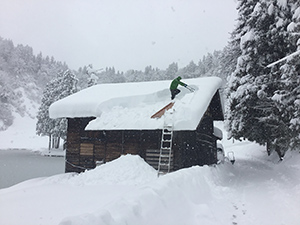 最近では日本でもインドの絵本のタラブックスが話題となっているが、主要な絵はワルリー画やゴンド画の若手が描いている。ゴンド画はマディヤ・プラデーシュ州(人口9,000万人)のもので、その創設者はジャンガル・シン・シュヤムさん。ジヴヤさんは6ケ月の滞在が3回、ジャンガルさんは3ヶ月の滞在が2回、それぞれインドでは見る事のできない大作を残している。インドの5大アーティストと言われる作家は亡くなり次の世代になっている。
最近では日本でもインドの絵本のタラブックスが話題となっているが、主要な絵はワルリー画やゴンド画の若手が描いている。ゴンド画はマディヤ・プラデーシュ州(人口9,000万人)のもので、その創設者はジャンガル・シン・シュヤムさん。ジヴヤさんは6ケ月の滞在が3回、ジャンガルさんは3ヶ月の滞在が2回、それぞれインドでは見る事のできない大作を残している。インドの5大アーティストと言われる作家は亡くなり次の世代になっている。 その世代は先代には残っていた祖霊神や悪霊への畏怖、部族神や神々、宇宙神への信仰が薄くなり、自然、宇宙とのコミュニケーションも退化しつつあり、結果としてデザイン的にスマートになっている。その意味からもミティラー美術館の収蔵品は重要となる。忘れてはならないのは37年間毎年屋根の雪掘りによって作品が守られてきた事、美術館の他、倉庫、倉庫にした民家、ゲストハウス等を含み6軒の家を使用している。屋根の総面積は美術館の屋根の面積に等しい。
その世代は先代には残っていた祖霊神や悪霊への畏怖、部族神や神々、宇宙神への信仰が薄くなり、自然、宇宙とのコミュニケーションも退化しつつあり、結果としてデザイン的にスマートになっている。その意味からもミティラー美術館の収蔵品は重要となる。忘れてはならないのは37年間毎年屋根の雪掘りによって作品が守られてきた事、美術館の他、倉庫、倉庫にした民家、ゲストハウス等を含み6軒の家を使用している。屋根の総面積は美術館の屋根の面積に等しい。 二つ目は、インド国外最大規模のインドフェスティバル、インドと日本の相互理解を深めるための文化交流イベント「ナマステ・インディア」の継続と発展に貢献してきたことだ。ナマステ・インディアは昨年で27回、四半世紀を越えた。葛西周辺にはインド人が7千人住んでるが、日本全体では4万人程度。英国は100万人、米国は430万人、ホワイトハウスには千人のインド人が働いている。
二つ目は、インド国外最大規模のインドフェスティバル、インドと日本の相互理解を深めるための文化交流イベント「ナマステ・インディア」の継続と発展に貢献してきたことだ。ナマステ・インディアは昨年で27回、四半世紀を越えた。葛西周辺にはインド人が7千人住んでるが、日本全体では4万人程度。英国は100万人、米国は430万人、ホワイトハウスには千人のインド人が働いている。 ミティラー美術館に事務局を置く「NPO法人日印交流を盛り上げる会」が主幹し日本で開催される「ナマステ・インディア」はインド国外では世界一の規模とインド大使館からお墨付きを与えられており、2日間で20万人の来場者で大変な盛り上がりになっている。
ミティラー美術館に事務局を置く「NPO法人日印交流を盛り上げる会」が主幹し日本で開催される「ナマステ・インディア」はインド国外では世界一の規模とインド大使館からお墨付きを与えられており、2日間で20万人の来場者で大変な盛り上がりになっている。 インドは多民族国家で地域ごとに文化や言語が異なり、横の連携がとりにくいのが、他の国でのイベントの規模の制約になっているのだろう。
インドは多民族国家で地域ごとに文化や言語が異なり、横の連携がとりにくいのが、他の国でのイベントの規模の制約になっているのだろう。 イベント終了後の美術品の撤去にも他の学芸員と少し協力したことがある。一度だけ運転手がいないとかで十日町まで4トンパネルバントラックで代々木公園を夜中の12時に出発したこともあった。長谷川にとっては毎年のことだ。撤去にはインド政府派遣の舞踊団、ボランティア、長谷川の支援者たちが当たり前の様に協力しあっていた。
イベント終了後の美術品の撤去にも他の学芸員と少し協力したことがある。一度だけ運転手がいないとかで十日町まで4トンパネルバントラックで代々木公園を夜中の12時に出発したこともあった。長谷川にとっては毎年のことだ。撤去にはインド政府派遣の舞踊団、ボランティア、長谷川の支援者たちが当たり前の様に協力しあっていた。 メインステージは全国から舞踊・音楽グループの出演応募が多くある。祭りであるイベントで参加したい人ができるだけ参加できるよう、1チームの時間を短くし、昨年は2日間で850名が参加している。ステージには12年前から毎年北海道平取町からアイヌ舞踊団(8〜16名)が参加。会場のセミナーハウスで講演のほかアイヌハウスまである。インドには少数民族、部族が500もある多民族国家。日本からも先住民族アイヌが参加すべきというメッセージだ。どうしてアイヌが毎年出るの?日本人もインド人も頭を傾けた。ステージや講演会で思いを述べる長谷川の姿を何度か見た。インドにも21名のアイヌ民族が文化使節団として2013年にコルカタ、ムンバイ、デリーで公演している。各開催地では来日した舞踊団や音楽家が参加協力。ムンバイでは奥地に住むインド先住民族ワルリーの村を訪れ交流もしている。アイヌ文化使節団21名の規模はアイヌ文化史上初めてと言う。ナマステ・インディア参加経費はアイヌ文化振興財団から協力を得られない時もアイヌ、事務局双方が負担し合って継続している。大変な心ある出来事だ。近年まであるいは今でも負(土人などと呼ばれたりする差別)を持つことのあるアイヌ、そのアイヌ文化の素晴しさを伝えようとしている。最近では国立歴史民俗博物館もアイヌハウスというブースに展示物を提供、アイヌ文化専門の助教授も毎年ボランティアで協力している。
メインステージは全国から舞踊・音楽グループの出演応募が多くある。祭りであるイベントで参加したい人ができるだけ参加できるよう、1チームの時間を短くし、昨年は2日間で850名が参加している。ステージには12年前から毎年北海道平取町からアイヌ舞踊団(8〜16名)が参加。会場のセミナーハウスで講演のほかアイヌハウスまである。インドには少数民族、部族が500もある多民族国家。日本からも先住民族アイヌが参加すべきというメッセージだ。どうしてアイヌが毎年出るの?日本人もインド人も頭を傾けた。ステージや講演会で思いを述べる長谷川の姿を何度か見た。インドにも21名のアイヌ民族が文化使節団として2013年にコルカタ、ムンバイ、デリーで公演している。各開催地では来日した舞踊団や音楽家が参加協力。ムンバイでは奥地に住むインド先住民族ワルリーの村を訪れ交流もしている。アイヌ文化使節団21名の規模はアイヌ文化史上初めてと言う。ナマステ・インディア参加経費はアイヌ文化振興財団から協力を得られない時もアイヌ、事務局双方が負担し合って継続している。大変な心ある出来事だ。近年まであるいは今でも負(土人などと呼ばれたりする差別)を持つことのあるアイヌ、そのアイヌ文化の素晴しさを伝えようとしている。最近では国立歴史民俗博物館もアイヌハウスというブースに展示物を提供、アイヌ文化専門の助教授も毎年ボランティアで協力している。 長谷川氏との出会いは1986年に「たばこと塩の博物館」で開催した「中国広西少数民族くらし展」からだ。有名な桂林がある広西チワン族自治区に住む12の少数民族の織布と楽器の展覧会。これは日本文化のルーツの一つと知られる南中国少数民族文化が世界で初めて公開されるという貴重な文物。広西芸術学院大学が16年にわたり調査研究した成果でもある。現地に研究者が入る許可が下りない時代、4年越しの粘り強い交渉の末借り出すことに成功したものだ。
長谷川氏との出会いは1986年に「たばこと塩の博物館」で開催した「中国広西少数民族くらし展」からだ。有名な桂林がある広西チワン族自治区に住む12の少数民族の織布と楽器の展覧会。これは日本文化のルーツの一つと知られる南中国少数民族文化が世界で初めて公開されるという貴重な文物。広西芸術学院大学が16年にわたり調査研究した成果でもある。現地に研究者が入る許可が下りない時代、4年越しの粘り強い交渉の末借り出すことに成功したものだ。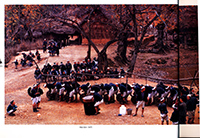
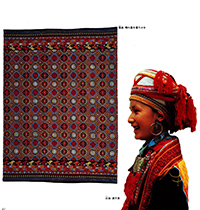 しかも新潟県内10ヶ市町村から始まり札幌から京都、鹿児島黎明館等を巡回した後、最後東京で開催。東京で開催しメディアから全国発信し地方展開というパターンに逆行していた。長谷川は地方に住み、新しい音楽を一緒にする仲間が見つからないと言う。ほとんど音楽をする人は東京の真似をするだけ、東京はニューヨークやパリを真似しているのでは、日本のオリジナルな文化は出きない。
しかも新潟県内10ヶ市町村から始まり札幌から京都、鹿児島黎明館等を巡回した後、最後東京で開催。東京で開催しメディアから全国発信し地方展開というパターンに逆行していた。長谷川は地方に住み、新しい音楽を一緒にする仲間が見つからないと言う。ほとんど音楽をする人は東京の真似をするだけ、東京はニューヨークやパリを真似しているのでは、日本のオリジナルな文化は出きない。 地方の未来に必要な最も新しい文化を体験する機会を地方に作らないと、という意気込みで草の根で実践していく。日本の各地でこの貴重な展覧会に学者達もボランティアで協力していった。会場で公開されたビデオは特に貴重なもので瑤族の中でも最も古い文化を保持している白?瑤(ペークーヤオ)族(30,000人)の生活、儀礼が紹介されていた。京都思文閣美術館の展覧会を訪れた奈良国立文化財研究所所長の故坪井清足氏はビデオが流れるテレビの前で座り込み微塵も動かなかったそうだ。日本の弥生文化研究を代表する人物の姿に関係者はそれ程このビデオは貴重なんだと驚いた。
地方の未来に必要な最も新しい文化を体験する機会を地方に作らないと、という意気込みで草の根で実践していく。日本の各地でこの貴重な展覧会に学者達もボランティアで協力していった。会場で公開されたビデオは特に貴重なもので瑤族の中でも最も古い文化を保持している白?瑤(ペークーヤオ)族(30,000人)の生活、儀礼が紹介されていた。京都思文閣美術館の展覧会を訪れた奈良国立文化財研究所所長の故坪井清足氏はビデオが流れるテレビの前で座り込み微塵も動かなかったそうだ。日本の弥生文化研究を代表する人物の姿に関係者はそれ程このビデオは貴重なんだと驚いた。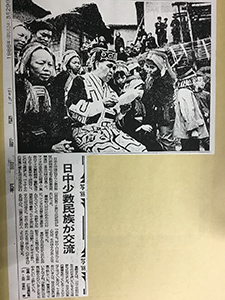 萱野茂氏も参加し大瑤山では「日中の少数民族の交流」というとても良い国際交流が実現した。私も参加させて貰ったが日本各地で展覧会に協力した学者、専門家が集い、未公開地域を調査、広西芸術学院の専門家と民族事務委員会の協力で大変な成果となった。その後、参加した鈴木正崇氏は国立民族学博物館の藤井知昭副館長、百田弥栄子氏と白?瑤族の村を訪れている。このプロジェクトの参加者には次の研究の大きな糧となっていることがわかる。
萱野茂氏も参加し大瑤山では「日中の少数民族の交流」というとても良い国際交流が実現した。私も参加させて貰ったが日本各地で展覧会に協力した学者、専門家が集い、未公開地域を調査、広西芸術学院の専門家と民族事務委員会の協力で大変な成果となった。その後、参加した鈴木正崇氏は国立民族学博物館の藤井知昭副館長、百田弥栄子氏と白?瑤族の村を訪れている。このプロジェクトの参加者には次の研究の大きな糧となっていることがわかる。 さてナマステ・インディアに話を戻すと、長谷川は代々木公園に会場を移すとき、インドと言えば哲学、楽しいイベントの中にも哲学に触れる場を作れないかと考えた。88‘インド祭の時にお世話になった故中村元氏が始めた東方学院が参加してくれる事になった。ボランティアで継続しているこの学院のテナント料は無償にした。イベントの初日には毎年、故奈良康明氏、前田専學氏という日本の仏教哲学、東洋宗教哲学を代表する両氏から丁寧に感謝の言葉を頂いていた。イベントの発展とともに大型テントで東方学院主体の連続講演会が可能となる東方学院セミナーハウスも実現している。
さてナマステ・インディアに話を戻すと、長谷川は代々木公園に会場を移すとき、インドと言えば哲学、楽しいイベントの中にも哲学に触れる場を作れないかと考えた。88‘インド祭の時にお世話になった故中村元氏が始めた東方学院が参加してくれる事になった。ボランティアで継続しているこの学院のテナント料は無償にした。イベントの初日には毎年、故奈良康明氏、前田専學氏という日本の仏教哲学、東洋宗教哲学を代表する両氏から丁寧に感謝の言葉を頂いていた。イベントの発展とともに大型テントで東方学院主体の連続講演会が可能となる東方学院セミナーハウスも実現している。 2011年東日本大震災後インド国家災害対応部隊(NDRF)46名が宮城県女川町に入った。その3年後に、インド大使から現地支援としてインド政府派遣舞踊団(8〜15名)公演を女川町で開催したいと依頼され、毎年実現している。2016年には駅や商業施設が稼働するようになり、人を呼び込む目的も兼ねナマステ・インディア女川を、インド大使館や町役所の協力のもとに、5月連休中に開催した。その後、これが継続し今年で5回目となる。代々木公園でのナマステ・インディアでも女川町のブースを設け、当時インドレスキュー隊のボランティア通訳をした若者が中心にインド大使館、インド関係者との交流の写真パネルや町の物産、観光紹介などを行なっている。ナマステ・インディア会場を訪れた日本の仏教僧が驚かれた。NPOエリアのテントを覗くと菩提僊那像があったからだ。
2011年東日本大震災後インド国家災害対応部隊(NDRF)46名が宮城県女川町に入った。その3年後に、インド大使から現地支援としてインド政府派遣舞踊団(8〜15名)公演を女川町で開催したいと依頼され、毎年実現している。2016年には駅や商業施設が稼働するようになり、人を呼び込む目的も兼ねナマステ・インディア女川を、インド大使館や町役所の協力のもとに、5月連休中に開催した。その後、これが継続し今年で5回目となる。代々木公園でのナマステ・インディアでも女川町のブースを設け、当時インドレスキュー隊のボランティア通訳をした若者が中心にインド大使館、インド関係者との交流の写真パネルや町の物産、観光紹介などを行なっている。ナマステ・インディア会場を訪れた日本の仏教僧が驚かれた。NPOエリアのテントを覗くと菩提僊那像があったからだ。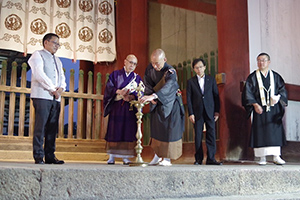 テント内のパネルには所せましと2012年の日印国交樹立60周年記念として東大寺中門や大仏殿で奉納されたインド政府派遣の舞踊や、古典声楽ドゥルパッドの写真パネルが展示されている。菩提僊那は、日印交流の始まりと言われており、奈良時代に日本に初めて来た最初のインド人でありバラモン僧と知られ、病弱な聖武上皇に請われて大仏の開眼導師になりその後も国際交流センターであった大安寺で仏教、サンスクリットを日本僧に教えた。
テント内のパネルには所せましと2012年の日印国交樹立60周年記念として東大寺中門や大仏殿で奉納されたインド政府派遣の舞踊や、古典声楽ドゥルパッドの写真パネルが展示されている。菩提僊那は、日印交流の始まりと言われており、奈良時代に日本に初めて来た最初のインド人でありバラモン僧と知られ、病弱な聖武上皇に請われて大仏の開眼導師になりその後も国際交流センターであった大安寺で仏教、サンスクリットを日本僧に教えた。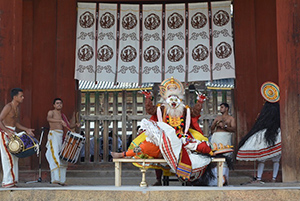 周年事業で終えるのではなく、日印両国の教科書に菩提僊那の偉業が載るまで続けようと長谷川が継続してきた。今年で9年目になる。
周年事業で終えるのではなく、日印両国の教科書に菩提僊那の偉業が載るまで続けようと長谷川が継続してきた。今年で9年目になる。 菩提僊那継承事業に毎年インド政府から派遣される舞踊・音楽グループの全国公演で公開されている。それ以外はミティラー美術館で公開されている。
菩提僊那継承事業に毎年インド政府から派遣される舞踊・音楽グループの全国公演で公開されている。それ以外はミティラー美術館で公開されている。 2007年〜2008年の日印交流年では積み重ねた日本全国のネットワークや経験を生かしインド政府派遣舞踊・音楽、25のグループを北は利尻から南西は沖縄与那国まで162公演3展覧会を長谷川は実現している。インド大使館が出した交流年の記念誌にはミティラー美術館を訪れたシン大使夫妻の写真や長谷川の犬まで載せてある。日印交流交流年賞をわざわざ日印協会会長森喜朗氏から長谷川に手渡す演出を大使はしている。中古の4輪駆動のマイクロバスにはインド政府観光局により派手なインドの写真がプリントされ、大使が運転する写真まで載せてある。このバスで長谷川は全国を回った。各離島のほか、噴火した三宅島。中越大震災の川口町、小千谷市、山古志村の仮設住宅、アイヌ民族が住む北海道二風谷など。各地の住民は、本物のインド文化に触れることができた。こうした交流のミニ版を毎年継続している。
2007年〜2008年の日印交流年では積み重ねた日本全国のネットワークや経験を生かしインド政府派遣舞踊・音楽、25のグループを北は利尻から南西は沖縄与那国まで162公演3展覧会を長谷川は実現している。インド大使館が出した交流年の記念誌にはミティラー美術館を訪れたシン大使夫妻の写真や長谷川の犬まで載せてある。日印交流交流年賞をわざわざ日印協会会長森喜朗氏から長谷川に手渡す演出を大使はしている。中古の4輪駆動のマイクロバスにはインド政府観光局により派手なインドの写真がプリントされ、大使が運転する写真まで載せてある。このバスで長谷川は全国を回った。各離島のほか、噴火した三宅島。中越大震災の川口町、小千谷市、山古志村の仮設住宅、アイヌ民族が住む北海道二風谷など。各地の住民は、本物のインド文化に触れることができた。こうした交流のミニ版を毎年継続している。 昨年のナマステ・インディアにはマニプール州政府が24名の文化使節団を派遣した。インドの州政府が日本の友好都市に10名以内の舞踊団を派遣する事も稀なのに異例の事だった。文化大臣夫妻、以下局長家族、課長家族まで参加し、大臣以外は16日間にわたって新潟、刈谷市、京都、敦賀、東大阪市など全国13公演をしている。各会場ではニラマニデヴィさんの弟子の女性陶工がロクロを使用しない、古来の手法で公開制作し、人々を驚かせた。参加者は、ロクロ以前の日本の古代の陶芸に想いを馳せた。東京公演のためには、群馬県千代田町の寺に宿泊。大臣以下、自炊で寺の協力で無料宿泊。移動は長谷川が2時間以上毎日マイクロを運転。観光に金閣寺、東大寺にも訪れている。大使公邸に招待されたり、京都、大阪では総領事館が協力した。
昨年のナマステ・インディアにはマニプール州政府が24名の文化使節団を派遣した。インドの州政府が日本の友好都市に10名以内の舞踊団を派遣する事も稀なのに異例の事だった。文化大臣夫妻、以下局長家族、課長家族まで参加し、大臣以外は16日間にわたって新潟、刈谷市、京都、敦賀、東大阪市など全国13公演をしている。各会場ではニラマニデヴィさんの弟子の女性陶工がロクロを使用しない、古来の手法で公開制作し、人々を驚かせた。参加者は、ロクロ以前の日本の古代の陶芸に想いを馳せた。東京公演のためには、群馬県千代田町の寺に宿泊。大臣以下、自炊で寺の協力で無料宿泊。移動は長谷川が2時間以上毎日マイクロを運転。観光に金閣寺、東大寺にも訪れている。大使公邸に招待されたり、京都、大阪では総領事館が協力した。 東京国立博物館での特別展「コルカタ・インド博物館所蔵 インドの仏 仏教美術の源流」2015年3月17日(火)〜5月17日(日)開会式でテープカットをした後、インド大使のワドワ女史は長谷川のところに近寄り耳許で「貴方は影のヒーロー」と囁いた。この展覧会は準備期間が8ヶ月と言う、東京国立博物館始まって以来の短期間で開催されたが、これは革命的出来事だった。開催が実現したのは、日本博物館協会主催の全国博物館館長会議の後の交流会で長谷川が銭谷日本学物館協会会長にインドからきたばかりの資料を見せた事から始まる。東博の主要メンバーが素晴らしい文物だと言うことになったが、長谷川がインド政府は3ヶ月後に開催してほしいと希望していると言うと全員がびっくりした。上野までの経費、保険は一切出すと言っていると話すと、とにかくその様な短い期間は無理だが問題は会場が空いているかだとなり、翌日調べてみることになった。翌日大使館の文化担当と長谷川が東博を訪れると8ヶ月後に表慶館は可能という事になった。今度は大使館が本国と日程調整、開催が可能となる。後はスポンサー探しで日経が主催協力する事になった。
東京国立博物館での特別展「コルカタ・インド博物館所蔵 インドの仏 仏教美術の源流」2015年3月17日(火)〜5月17日(日)開会式でテープカットをした後、インド大使のワドワ女史は長谷川のところに近寄り耳許で「貴方は影のヒーロー」と囁いた。この展覧会は準備期間が8ヶ月と言う、東京国立博物館始まって以来の短期間で開催されたが、これは革命的出来事だった。開催が実現したのは、日本博物館協会主催の全国博物館館長会議の後の交流会で長谷川が銭谷日本学物館協会会長にインドからきたばかりの資料を見せた事から始まる。東博の主要メンバーが素晴らしい文物だと言うことになったが、長谷川がインド政府は3ヶ月後に開催してほしいと希望していると言うと全員がびっくりした。上野までの経費、保険は一切出すと言っていると話すと、とにかくその様な短い期間は無理だが問題は会場が空いているかだとなり、翌日調べてみることになった。翌日大使館の文化担当と長谷川が東博を訪れると8ヶ月後に表慶館は可能という事になった。今度は大使館が本国と日程調整、開催が可能となる。後はスポンサー探しで日経が主催協力する事になった。 7万人以上のチケットが売れないと赤字になる事がわかり、長谷川はまず外務省に広報に協力すべきものと熱意を持って話していく。しかしチラシに仏教と宗教の名が出ていて協力できない事を知る。主催の日経も同様の理由で仏教会に働きかけられない。長谷川が動けば動くほど日本社会の問題にぶつかった。日本の硬直した社会だ。入場者が7万人をこえるべく長谷川氏は仏教会や新宗教団体など声をかけたり、大使館からポスターチラシを自治体、大学、インドレストランまで配布してくれるよう動いた。在日インド人へのインフォメーション、メディア対策など、ナマステ・インディアと同様の宣伝活動を開催終了まで努力していた。長谷川はなぜ自分で図録を購入してまで京都、奈良の仏教会、新仏教会にまで送るのか? 理由は日本人の多くは仏教徒、無信仰といっても仏像が好きだ。その本家本物が、インドの博物館の学芸員が選んだものがくる。目玉の仏像を中心にして開催する経済を優先する日本で開催される主流の展覧会とは異なる。この様な質の高い展覧会は稀有な例で、大勢の国民が見れた方がいい。また、赤字になれば、急な話しだから、インドだからとなるだろう、次はないかもしれない。これは今後の日印交流の為にも成功させなければいけない、と考えて動いていく。これではお金がいくらあっても足りない、江戸文化の「宵越しの銭を持たない」を地でいっているようなところがある。
7万人以上のチケットが売れないと赤字になる事がわかり、長谷川はまず外務省に広報に協力すべきものと熱意を持って話していく。しかしチラシに仏教と宗教の名が出ていて協力できない事を知る。主催の日経も同様の理由で仏教会に働きかけられない。長谷川が動けば動くほど日本社会の問題にぶつかった。日本の硬直した社会だ。入場者が7万人をこえるべく長谷川氏は仏教会や新宗教団体など声をかけたり、大使館からポスターチラシを自治体、大学、インドレストランまで配布してくれるよう動いた。在日インド人へのインフォメーション、メディア対策など、ナマステ・インディアと同様の宣伝活動を開催終了まで努力していた。長谷川はなぜ自分で図録を購入してまで京都、奈良の仏教会、新仏教会にまで送るのか? 理由は日本人の多くは仏教徒、無信仰といっても仏像が好きだ。その本家本物が、インドの博物館の学芸員が選んだものがくる。目玉の仏像を中心にして開催する経済を優先する日本で開催される主流の展覧会とは異なる。この様な質の高い展覧会は稀有な例で、大勢の国民が見れた方がいい。また、赤字になれば、急な話しだから、インドだからとなるだろう、次はないかもしれない。これは今後の日印交流の為にも成功させなければいけない、と考えて動いていく。これではお金がいくらあっても足りない、江戸文化の「宵越しの銭を持たない」を地でいっているようなところがある。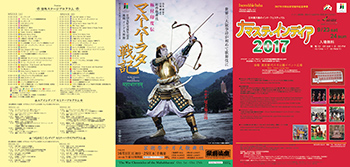 2017年日印友好交流年記念として歌舞伎座で10月に1ヵ月にわたり公演された新作歌舞伎 極付印度伝「マハーバーラタ戦記」に2017ナマステ・インディアは広告塔として大きく協力した。ナマステの時期が9月の最終土日とタイミングがよく、2日で20万人が集う会場では歌舞伎ハウスが会場中央に設置された。
2017年日印友好交流年記念として歌舞伎座で10月に1ヵ月にわたり公演された新作歌舞伎 極付印度伝「マハーバーラタ戦記」に2017ナマステ・インディアは広告塔として大きく協力した。ナマステの時期が9月の最終土日とタイミングがよく、2日で20万人が集う会場では歌舞伎ハウスが会場中央に設置された。 ステージでの歌舞伎役者と演歌歌手チャダ、インド大使が参加する開会式や航空券が当たるステージでの抽選会で松竹関係者が公演をアピールした。ホームページに大きく記載。当日配る当日チラシ、事前のチラシの1面広告、ポスターに写真入れ在日インド人関係者、インド関係団体、出演、出店企業、インドレストラン、大学、専門学校などに配布、掲示して貰った。
ステージでの歌舞伎役者と演歌歌手チャダ、インド大使が参加する開会式や航空券が当たるステージでの抽選会で松竹関係者が公演をアピールした。ホームページに大きく記載。当日配る当日チラシ、事前のチラシの1面広告、ポスターに写真入れ在日インド人関係者、インド関係団体、出演、出店企業、インドレストラン、大学、専門学校などに配布、掲示して貰った。